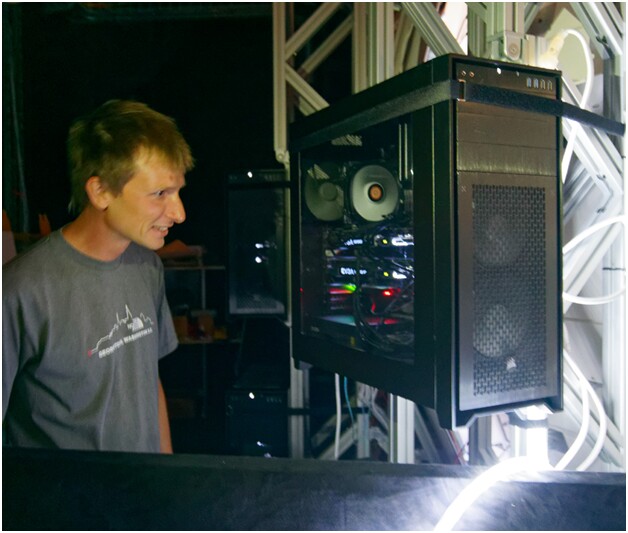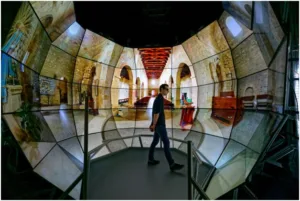Back in the fall of 1991, when many of you were still in school, and the old guys reading this were trying to figure out how to get two or more AIBs to work together, Tom DeFanti, Dan Sandin and colleagues designed the very first — and trademarked — CAVE.

They built it at the University of Illinois at Chicago Electronic Visualization Lab—that was the first functional, non-sickening, fully immersive walk-in VR system—26 years ago. You could move around in it, untethered, see 360 around, up and down, all in stereo 3D—interactively, it even had multi-channel audio.
If you want real VR you need to get the real thing.
Oh wait, but VR was invented by Facebook in 2015, wasn’t it?
Wazah CAVE? It is at a minimum, three, floor-to-ceiling, 10-foot (3 metre) wide rear-projection screens in a U-shape, left-front, right. That’s the minimum, adding a fourth for the floor was typical. The max is five to six screens which include floor, ceiling and the wall behind you (which creates a small problem of access, but in those days, everyone was a starving, skinny Ph.D. student and could easily slip in-between things (actually, the rear wall always moved).
Part of the inspiration for the CAVE came from StarTrek, and another part from the immersive planetariums that were being built then. There may have been some mathematical inspiration (Dan’s) too, but I wouldn’t know about that. (Believe it or not, Tom’s inspiration was a tailor’s 3-panel mirror.)
Now spin the time machine dial forward to 2017, and park it in Qualcomm Institute/ UC San Diego. Ask anyone on campus where Tom is is and they’ll point somewhere and say, “in da cave.” You do that two or three times and through a biased Bessel function you’ll find him, or maybe not, but you’ll find his latest development—the SunCAVE. Seventy, 4k flat panel displays, (45 (9 columns x 5 high) screens in front and another 25 (5×5) behind) with clever top and bottom inward tilt, to give it a sphere-like appearance, that displays 500 Megapixels and uses 70 AIBs to drive them all.
SunCAVE at the Qualcomm Institute/ UC San Diego
Once inside it, wearing lightweight passive glasses (like the type you wear at iMax and other 3D theaters) you can engage the presentation interactively (think about a 3D model being presented) through the use of an ART optical tracking system.
The 70 Nvidia 1080 and 1080-Ti AIBs are connected to the 70 screens via HDMI. They are installed in deskside PCs two per box and strapped to the back of the SunCAVE to minimize HDMI length (see picture). There is no special cooling (although the room was built for CAVEs, so it has plenty of cooling). They are pretty quiet, being deskside PCs with huge fans. The motherboard is a ASUS X99 E WS USB 3 1 motherboard SSI CEB LGA2011 v3/4 Socket X99. There are 45 PCs plus a head node, all with 40Gb/s NICs and a 3 2 GHz Xeon E5 1660V4 processor.
 PC with two GTX1080Ti strapped to the back of the display
PC with two GTX1080Ti strapped to the back of the display
The SunCAVE is a major installation, and not cheap, costing in the neighborhood of $350k. But it also serves as a 70-GPU machine learning compute cluster when nobody’s looking!
All that is the good news. The sad news is this may be the last passive 3D CAVE that will be built. That’s because LG no longer makes these screens with passive 3D and (as of now) it doesn’t seem like anyone else does. It is possible to commission custom screens (as in the CAVE2 at UIC) but at ~6-10x the cost. I Suggest a black market for used LG screens is possible. This can be a motivation to produce cheap synchable active stereo LCD panels!
The folks at Qualcomm Institute/ UC San Diego aren’t getting out of the CAVE business, and are looking at micro LED display for the next generation. That system is being designed with a fully active floor also.
CAVEs come in all sizes and shapes. They can be tricky to set up, to get the geometry and light balance right and then there is the content. Most of it has to scale up – who has 500 Mpix content?[2] We have the fantasy of building a three-sided CAVE here at Mt. Tiburon Testing Labs using Scalable Displays’ warping and balancing software. Maybe Tom will consult for us. – Jon Peddie
[1]Michael Deering built a very similar projection-based device in 1991/2 for Sun Microsystems, but it didn’t get commercialized.
[2]If it’s CGI-based, pretty simple, just dial up the res. If photographic based, you need super hig-res cameras like the CAVEcam (google it) or generate billion-point dense point clouds with Structure from Motion techniques.
This article is re-published with kind permission of Dr Jon Peddie and was originally published in ‘Jon Peddie’s Techwatch‘ Jon has recently a book “Augmented Reality: Where We Will All Live” published by Springer and available on Amazon.
This is the second time that I have heard of demand for LG Display’s passive 3D technology recently – the last one was at the LG European OLED Day in Munich last week. I still think it was not very well marketed at the time and better communication might have helped,.but in the end, the passive 3D baby was thrown out with the 3D TV bathwater! (BR)

